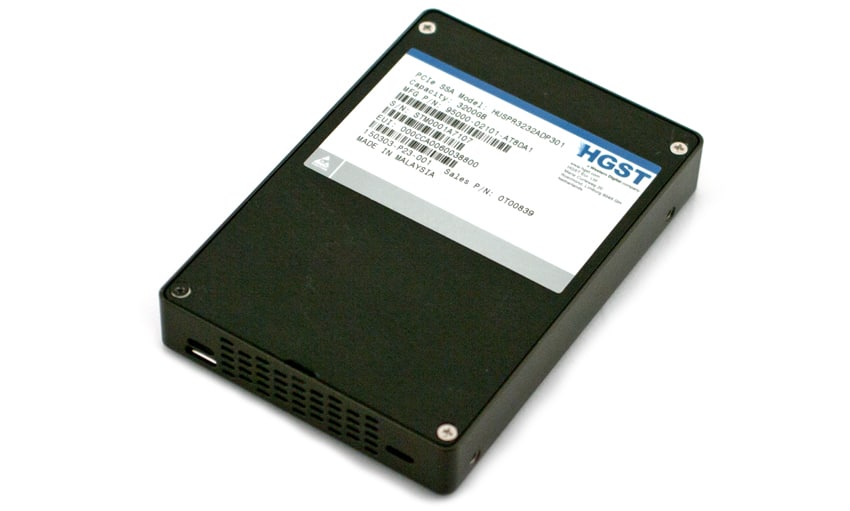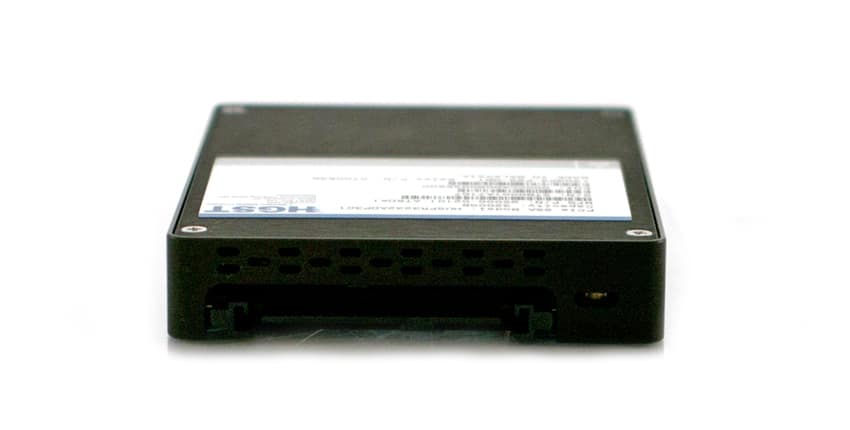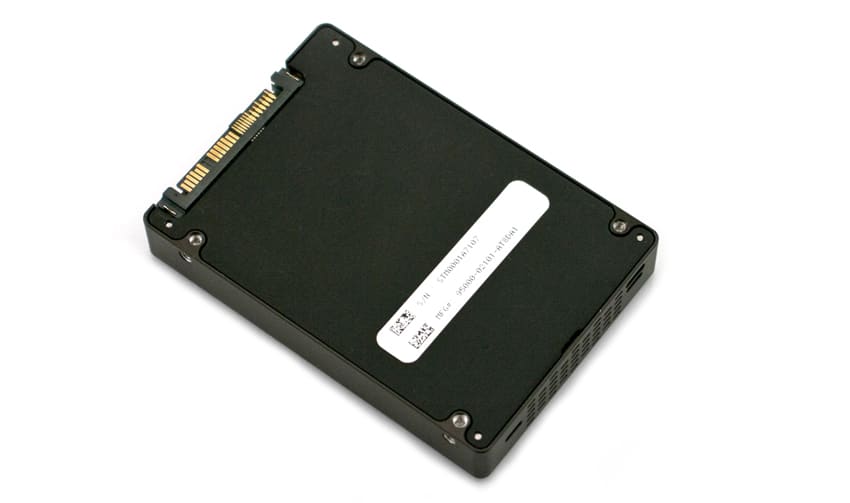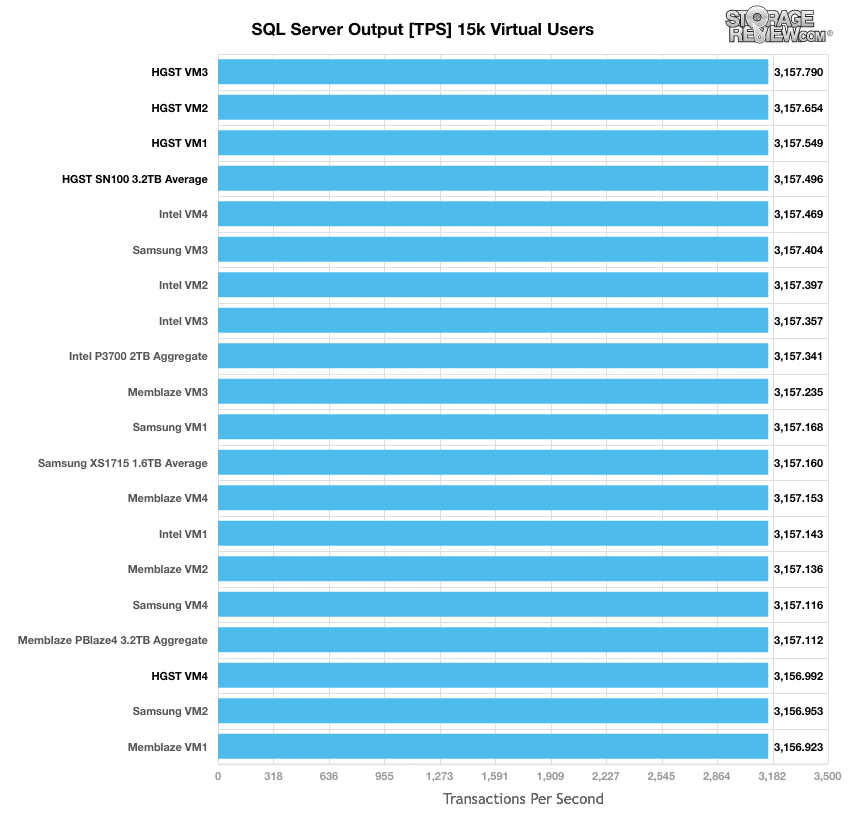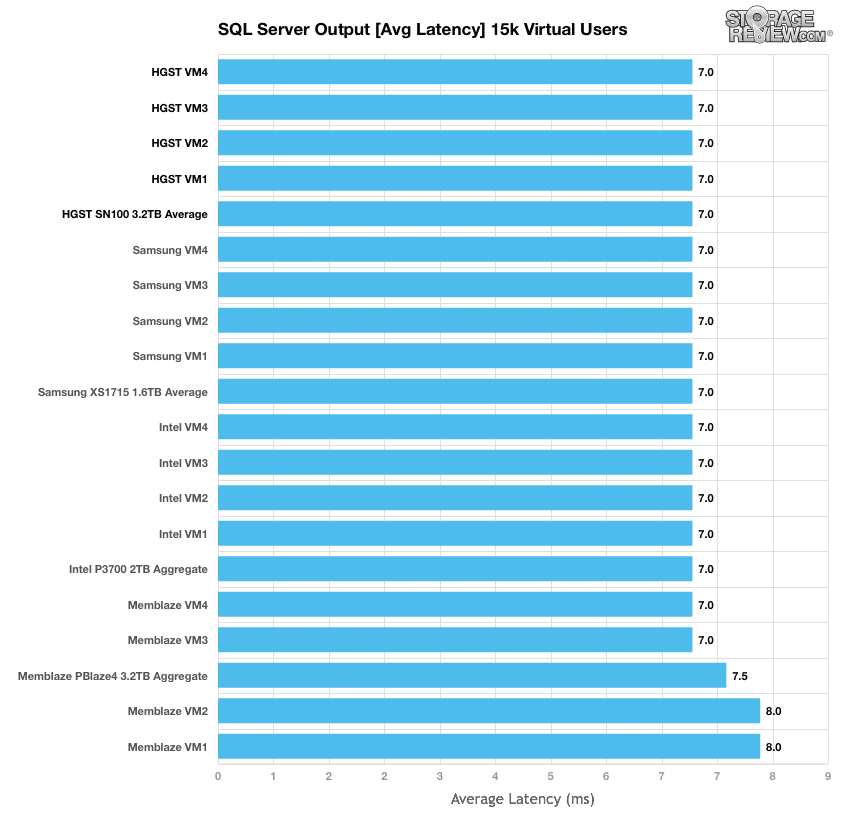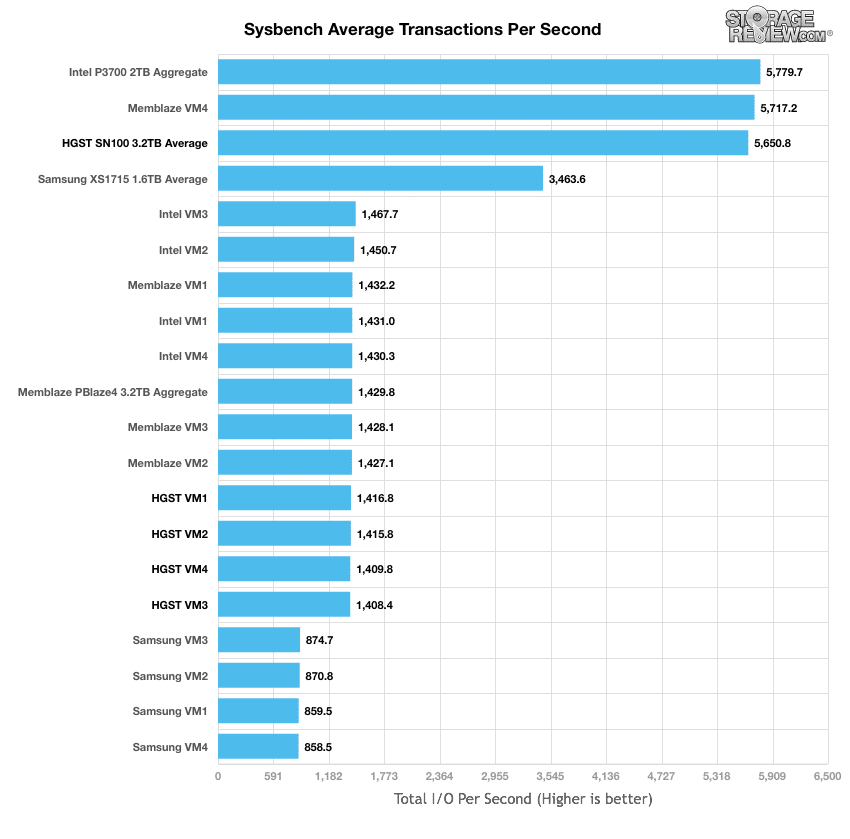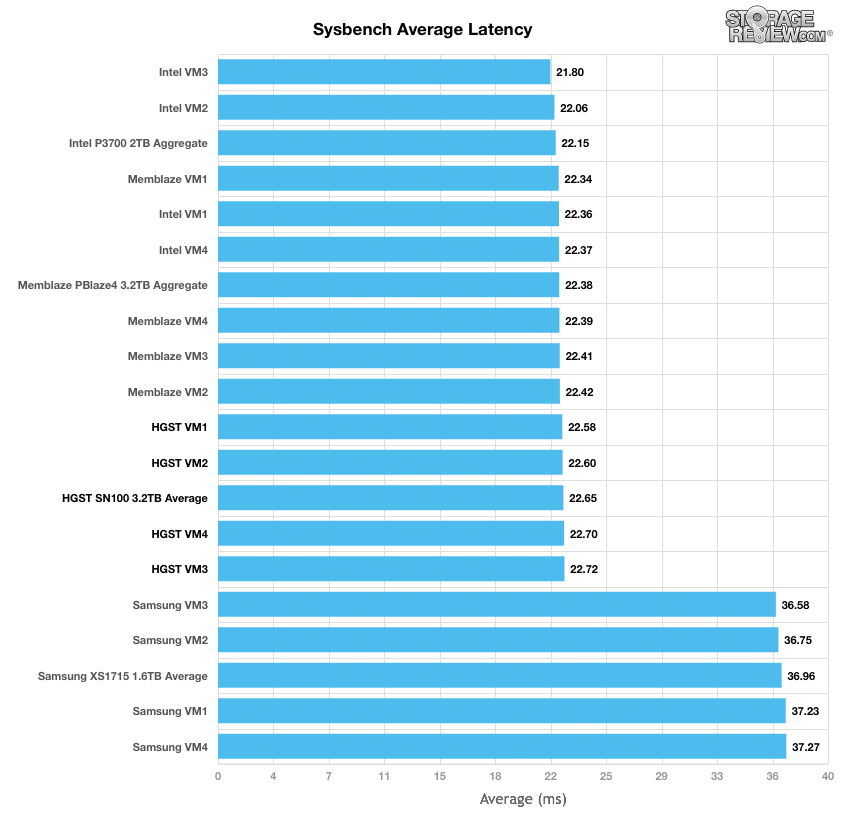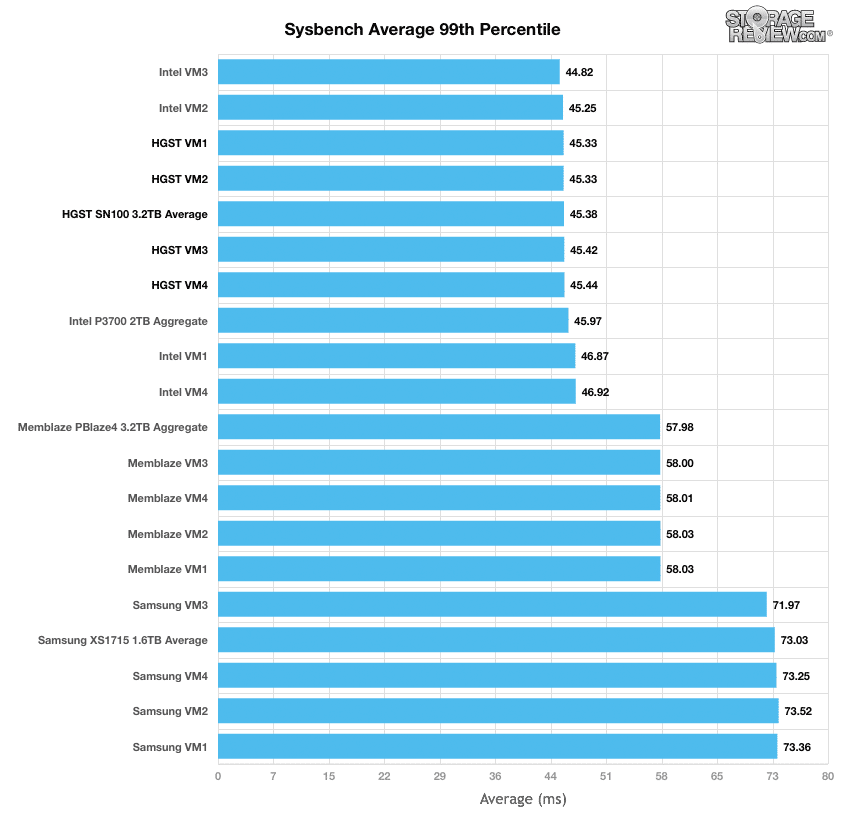
At the end of last year, we reviewed the HGST SN150 and found it to be a solid, good performing NVMe drive. The SN100 is the 2.5" equivalent and comes in capacities up to 3.2TB like the SN150. HGST's aim then is to make NVMe adoption easy, providing a wide range of form factors and capacities to suit most needs. The HGST Ultrastar SN100 series is specifically designed for data center professionals who need high application performance at a low total cost of ownership. While support for 2.5" NVMe drives doesn't match SAS in the enterprise, the benefits of front-of-server serviceability are front of mind for those wanting a familiar deployment model for their latency sensitive applications.
HGST quotes the SN100 with identical performance numbers compared to the SN150 and stresses that their NVMe drive will deliver consistent performance across all application workloads during the entire lifespan of the SSD. To that end, the SN100 offers performance up to 310,000 mixed random I/O performance, while read and write sequential speeds should reach 3GB/s and 1.6GB/s, respectively.
The HGST SN150 also has UEFI boot support. Not only does this help speed up boot times and resuming from hibernation, it also improves security by protecting the pre-startup process against bootkit attacks. In addition, the HGST NVMe drive features advanced power management and enterprise-grade reliability, the latter which consists of Flash-aware RAID, end-to-end data-path protection, advanced ECC, secure-erase, and power fail protection.
Back by a 5-year warranty, the SN100 comes in capacities of 800GB, 1.6TB, and 3.2TB.
HGST SN100 NVMe SSD Specifications
- Configuration
- Default capacities (GB): 3200 / 1600 / 800
- Capacity range (min-max GB): 2240-3820 / 1120-1910 / 560-955
- Interface: PCIe 3.0 x4 (8639)
- Form factors: SFF 2.5-inch drive
- Performance:
- Read throughput (max MB/s, sequential 128k): 3000 / 3000 / 2600
- Write throughput (max MB/s, sequential 128k): 1600 / 1600 / 1400
- Read IOPS (max IOPS, random 4k): 743,000 / 743,000 / 634,000
- Write IOPS (max IOPS, random 4k): 140,000 / 140,000 / 80,000
- Mixed IOPS (70/30 R/W, random 4k): 310,000 / 310,000 / 190,000
- Read IOPS (max IOPS, random 8k): 385,000 / 385,000 / 330,000
- Write IOPS (max IOPS, random 8k): 75,000 / 75,000 / 42,000
- Latency 512B (μs): 20 / 20 / 20
- Reliability
- MTBF4 (M hours):2.0
- Annual failure rate (AFR): 0.44% 0.44%
- Endurance: 3 DW/D
- Warranty: 5 Years
- Physical
- Dimensions, without bracket (mm): 100.45 x 69.85 x 15
- Weight, without bracket (g):177 / 174 / 166
- Environmental
- Power consumption (active/idle): 25 Watts / 8 Watts
- Operating temperature: 0° to 70°C
- Non-operating temperature: -40° to 70°C
- Airflow (LFM): 300
- Thermal throttling: Supported
- Temperature monitoring: In-band and out-band using SMBus
- PowerSafe® technology Data protection during power loss
- Power throttling Supported
- Power rails: 3.3V aux, 12V supply rail
- JEDEC compliance: 3-month retention at 40°C at EOL
- Operating Systems
- Linux RHEL 6/7, SLES 12, CentOS 6/7, Open SUSE 12
- Windows Microsoft Server 2008 R2, Windows 2012, Windows 2012 Server
- Software:
- HGST Device Manager (HDM): HDM 3.1 (CLI)
- NVMe standard: 1.1a
- Manufacturing Standards: Penang, Malaysia ISO 9001:2008 certified, ISO 14001:2004 certified
Design and build
As with most enterprise drives the SN100 has a very simple design. The SN100 is a SFF 2.5” form factor drive with a black metal case. The front of a drive contains a sticker with information such as model number and capacity as well as HGST branding on the right hand side.
The sides of the drive have screw holes for mounting and on either end there are ventilation holes for passive cooling.
The bottom of the drive is also no frills, with just a small sticker with serial number and manufacturer’s number.
Testing Background and Comparables
The StorageReview Enterprise Test Lab provides a flexible architecture for conducting benchmarks of enterprise storage devices in an environment comparable to what administrators encounter in real deployments. The Enterprise Test Lab incorporates a variety of servers, networking, power conditioning, and other network infrastructure that allows our staff to establish real-world conditions to accurately gauge performance during our reviews.
We incorporate these details about the lab environment and protocols into reviews so that IT professionals and those responsible for storage acquisition can understand the conditions under which we have achieved the following results. None of our reviews are paid for or overseen by the manufacturer of equipment we are testing. Additional details about the StorageReview Enterprise Test Lab and an overview of its networking capabilities are available on those respective pages.
We will be comparing the HGST SN100 with the Intel P3700, Memblaze PBlaze4, and Samsung XS1715 2.5” NVMe SSDs.
Application Workload Analysis
In order to understand the performance characteristics of enterprise storage devices, it is essential to model the infrastructure and the application workloads found in live production environments. Our first benchmarks for the HGST Ultrastar SN100 2.5” are therefore the MySQL OLTP performance via SysBench and Microsoft SQL Server OLTP performance with a simulated TCP-C workload. For our application workloads, each drive will be running 2-4 identically configured VMs.
StorageReview’s Microsoft SQL Server OLTP testing protocol employs the current draft of the Transaction Processing Performance Council’s Benchmark C (TPC-C), an online transaction processing benchmark that simulates the activities found in complex application environments. The TPC-C benchmark comes closer than synthetic performance benchmarks to gauging the performance strengths and bottlenecks of storage infrastructure in database environments. Each instance of our SQL Server VM for this review uses a 333GB (1,500 scale) SQL Server database and measures the transactional performance and latency under a load of 15,000 virtual users.
When looking at SQL Server Output, the HGST drive showed results at the top of the leaderboard with a leading TPS of 3,157.79 and an aggregate of 3,157.47 TPS.
Average latency results during the 15k user SQL Server benchmark told a similar story. Here, the HGST at the top of the leaderboard again (along with the Samsung and Intel drives), posting a latency of 7.0ms in all columns.
The next application benchmark consists of a Percona MySQL OLTP database measured via SysBench. This test measures average TPS (Transactions Per Second), average latency, as well as average 99th percentile latency. Percona and MariaDB are using the Fusion-io flash-aware application APIs in the most recent releases of their databases, although for the purposes of this comparison we test each device in their "legacy" block-storage modes.
In the average transactions per second benchmark, the HGST SN100 2.5” placed in the middle of the pack with an average score of 5,650.83 TPS. Individual VMs ranged from 1,408.4 TPS to 1,416.8 TPS.
When looking at average latency results, the HGST drive found itself in the middle of the pack again (though within 1.5ms of the leader), with individual VMs running between 22.58ms through 22.72ms and aggregate latency of 22.65ms. The Intel drive showed top results with 22.15ms aggregate.
In terms of our worst-case MySQL latency scenario (99th percentile latency), the HGST SN100 moved back to the top of the leaderboard with VMs running between 45.38ms and 58.00ms with an aggregate at just 45.38ms.
Conclusion
Overall, the HGST Ultrastar SN100 series is a high-performing NVMe drive that performs quite well with applications that can benefit from local low-latency storage. One of the most attractive features of this drive is its easy deployment capabilities; supporting stock NVMe drivers allows users to hit the ground running without installing additional software.
In our SQL Server TPC-C benchmark, which looks at SQL Server Output for 15,000 virtual users, the HGST drive showed results at the top of the leaderboard with a leading TPS of 3,157.79 and an aggregate of 3,157.47 TPS. In average latency, the SN100 was leading the pack again (in addition to the Samsung and Intel drives), posting a latency of 7.0ms for all VMs.
In our Sysbench tests, we saw strong performance from the SN100 2.5” drive. In the average transactions per second benchmark, the HGST SN100 2.5” placed in the middle of the leaderboard with an average of 5,650.83 TPS. Moving to average latency of the same test, the HGST performed in the middle of the pack again with individual VMs running between 22.58ms through 22.72ms and aggregate latency of 22.65ms. Results of our worst-case MySQL latency test (99th percentile latency) showed the HGST SN100 back at the top of the leaderboard, with VMs running between 45.38ms and 58.00ms as well as an aggregate at just 45.38ms.
Pros
- Strong performance in application workloads
- 3.2TB max capacity in a 2.5" form factor
Cons
- Slight performance hit versus the add-in-card version
Bottom Line
The HGST SN100 is an NVMe drive that delivers strong performance in a flexible and easy to adopt 2.5” form factor.
HGST Ultrastar SN100 Series Product Page
Sign up for the StorageReview newsletter

